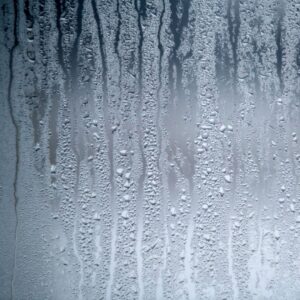Ever gotten out of a steamy shower, dried off, only to feel like you’re sticky and sweaty again? It’s because the bathroom was humid from the shower. As you know, eventually, this much humidity can cause mildew to grow on the ceiling of your bathroom.
A similar thing happens in vented crawl spaces every summer in places that have humid weather. The ground releases moisture as part of the water cycle. Most of the time it just dissipates up into the sky and makes clouds, eventually rain. But when you put a house with a crawl space on the ground, the ground still releases the moisture, but it doesn’t dissipate. It hangs out. And festers. Just like the damp air in a bathroom can cause mildew, damp crawl space air can cause mold and mildew on the floor beams and joists in a crawl space.

You may think, ‘What about the vents? Why doesn’t the air just escape through the vents?’ They actually make the humidity worse. Because of a phenomenon called ‘The Stack Effect’, air in the house rises. It starts with the hot air in the attic. It rises out of the seams in the attic. This causes a pull on the air beneath it, like water in a straw. The force of the pull carries down all the way into the crawl space. The crawl space air seeps through minuscule cracks in the floor and up into the house. This suction pulls outside air right in through the open vents in the crawlspace. Unfortunately, in the summer, ‘outside’ conatins a never-ending supply of more damp air.

This simple scientific phenomenon has caused destruction to homes in humid regions across America. But there’s a solution. While in a damp bathroom you can install a fan vent, this won’t work in a crawl space. Instead, you can install a dehumidifier. Dehumidifiers condense the moisture in the air and turn it into liquid water that can be pumped out and away from the home. This magical machine that can change the phase of matter will not put up with you for long if you don’t cut it a break though. That’s why there’s the need to pair a dehumidifier with plastic to cover the ground, the walls, and the concrete columns of the crawl space, and close the vents. This combination of a dehumidifier and a plastic liner to close the crawl space off from outside air is called an encapsulation. It’s a proven way to keep humid air from wrecking homes.
This article was written by Erin Blackburn, Marketing Director at Dry Otter Waterproofing, an independently owned, North Carolina-based company that also specialized in crawl space and basement waterproofing solutions. As a former science educator, she loves to share the science behind foundation waterproofing solutions.
Don’t Wait—Get a Free Estimate Today

Are you concerned about how Virginia’s humidity may be affecting your foundation? Contact Copper Fox Foundation Solutions for a free estimate. Serving Central and Southern Virginia, including Lynchburg, Staunton, and Danville, we’re here to ensure your home remains stable, dry, and secure—no matter what’s happening outside.
Call us today at (540) 351-2134 or contact us online to schedule your consultation. Let Copper Fox Foundation Solutions protect your foundation against the woes of humidity.

